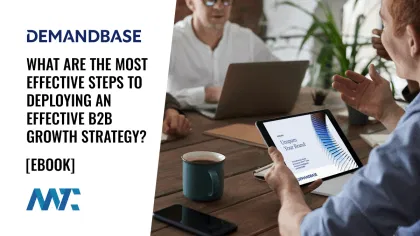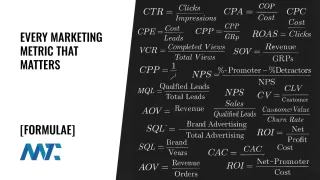What Are The Most Effective Steps to Deploying an Effective B2B Growth Strategy?

For B2B marketers seeking to drive sustainable growth in an increasingly complex landscape, traditional lead-centric strategies are no longer sufficient. Buyers are more anonymous, independent, and digitally savvy than ever. To break through this noise and inefficiency, many organizations are shifting to a modern B2B growth strategy rooted in account-based thinking and buyer-centric engagement.
Based on insights drawn from a comprehensive industry guide from Demandbase, here is a clear roadmap to deploying a successful B2B growth strategy in five essential steps.
Table of Contents
Build a Foundation with Account Intelligence
The first step toward an effective B2B growth strategy is establishing a strong foundation of account intelligence. Unlike traditional go-to-market models that rely on individual leads, account-based approaches prioritize complete visibility into the company or buying group. This involves aggregating data from multiple systems, including CRM, marketing automation, intent signals, web analytics, technographics, and more, into a single, unified view.
Effective account intelligence goes beyond just identifying potential buyers. It seeks to understand their behavior, uncover buying signals, and determine when and how they prefer to be engaged. This unified, enriched dataset allows for the following:
- Identifying high-value accounts early in the buying cycle.
- Mapping relationships within the buying committee.
- Aligning cross-functional revenue teams around a shared understanding of each account.
- Delivering insights that are contextual and timely for sellers.
Without this foundation, organizations risk account blindness—the inability to identify in-market prospects or deliver meaningful engagement throughout the buyer journey.
Identify and Prioritize the Right Accounts
Not all accounts are created equal. The second critical step is to determine which accounts are most likely to generate revenue and align with your company’s ideal customer profile (ICP). This isn’t a static list; it’s a dynamic process of selection based on both firmographic fit and behavioral signals of interest or intent.
A common framework used here is FIRE:
- Fit: Do the account’s demographics align with your ICP?
- Intent: Are they showing signs of researching relevant topics?
- Recency: How recently have they engaged with relevant content?
- Engagement: Are they actively interacting with your brand?
Using a scoring model or AI-driven analysis to evaluate accounts across these dimensions helps marketers and sellers focus efforts only on the opportunities that are most likely to progress. This focus creates a more efficient pipeline and enables precise budget allocation.
Engage with Personalized, Orchestrated Experiences
Once the right accounts are identified, the next step is engagement—but not through generic, one-size-fits-all tactics. Effective engagement involves creating tailored experiences that align with the account’s current stage in its journey. This goes far beyond marketing automation workflows. It involves coordinated, cross-channel interaction strategies that adapt to the account’s level of interest and buying stage.
This engagement can be broken down into several subcomponents:
- Understand: Use data to understand what an account cares about and how to connect most effectively.
- Personalize: Deliver content and messaging tailored to specific personas within the account.
- Advertise: Utilize targeted display and social advertising to maintain visibility and reinforce your messaging.
- Interact: Build channels for two-way communication, whether through sales conversations, content hubs, chat experiences, or events.
- Orchestrate: Align all interactions—marketing, sales, and customer success—around a unified playbook for each account.
This level of orchestration transforms disjointed touches into a cohesive and value-added experience for the buyer.
Align Sales and Marketing to Close Opportunities
Sales and marketing alignment has long been a challenge for B2B organizations. To deploy effective strategies, alignment isn’t just philosophical—it’s operational. Both teams should work from the same data, target the same accounts, and contribute to a shared set of metrics and goals.
This step involves:
- Collaborative planning between marketing and sales on target account strategies.
- Shared ownership of marketing qualified accounts (MQAs), not just leads.
- Real-time sharing of engagement insights to inform outreach.
- Joint pipeline reviews and revenue-based performance evaluations.
By breaking down the silos between marketing and sales, organizations can reduce friction, improve the buyer experience, and accelerate deal velocity.
Measure and Optimize for Account Progress
Ultimately, a modern B2B growth strategy must be measured not only in terms of clicks and conversions but also in terms of account progression. Traditional marketing analytics fall short because they focus on individual interactions rather than the collective behavior of buying teams.
Instead, marketers should track:
- Stage progression: How are accounts moving from awareness to consideration, to decision, to post-sale?
- Account engagement: Who is engaging, how often, and through which channels?
- Pipeline impact: Which campaigns are contributing to opportunity creation and pipeline acceleration?
- Revenue outcomes: Which accounts are closing, expanding, and renewing—and what touchpoints influenced those outcomes?
Modern analytics platforms can offer multi-touch attribution models and predictive insights that help marketers continuously refine strategy based on what’s working.
Think Big, Start Small, Scale Fast
Deploying a smarter B2B growth strategy is not an overnight transformation. The most successful companies take a phased approach:
- Establish: Begin with a pilot, demonstrating early value and establishing a solid data foundation.
- Operationalize: Introduce repeatable processes and scale to more accounts.
- Grow: Expand programs across segments with complete marketing and sales orchestration.
- Optimize: Utilize data to refine and improve account experiences continually.
Whether you’re targeting a few strategic accounts or scaling to thousands, the same five steps apply—adapted in intensity and investment depending on the account value.
Download the Complete B2B Growth Playbook
This article only scratches the surface of what’s possible with a modern, account-based B2B growth strategy. For a comprehensive overview of each step, including frameworks, tactics, and technology guidance, download the full eBook from Demandbase. It’s a must-read for B2B marketers and revenue teams ready to move beyond fragmented tactics and adopt a more intelligent, coordinated, and effective approach to driving growth.
Download The Clear & Complete Guide to Smarter GTM with Account Intelligence and ABX







